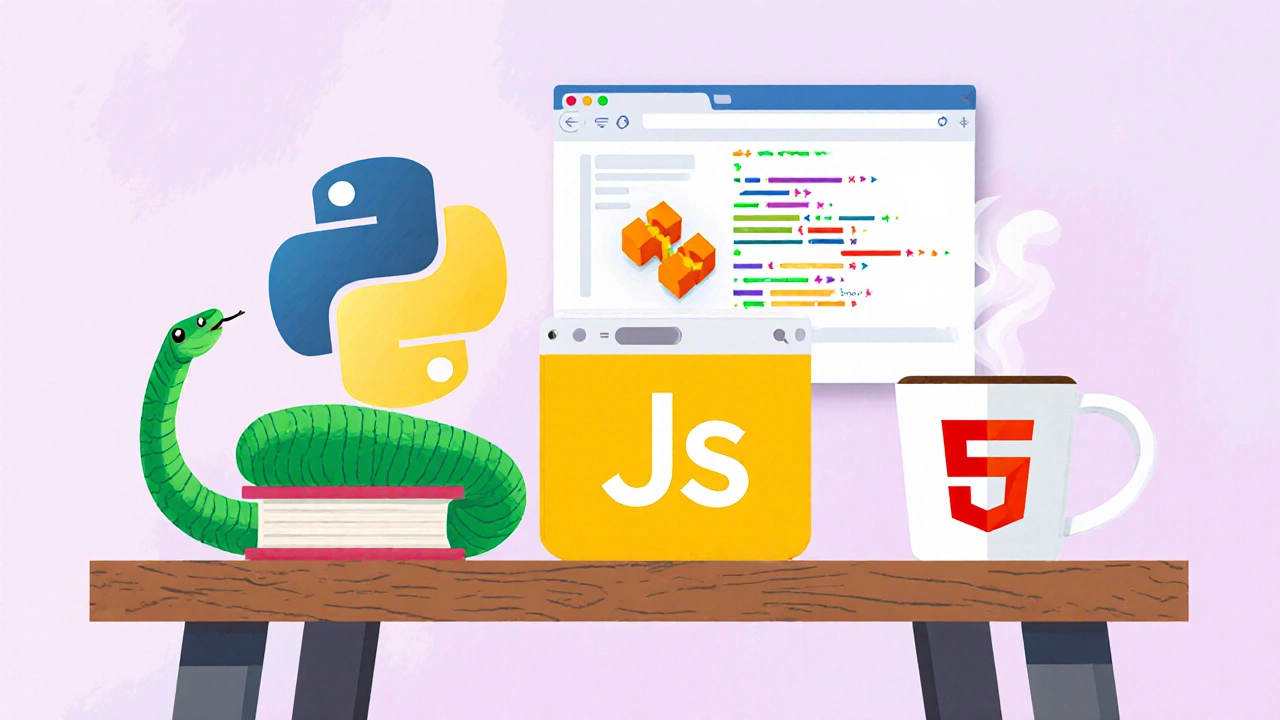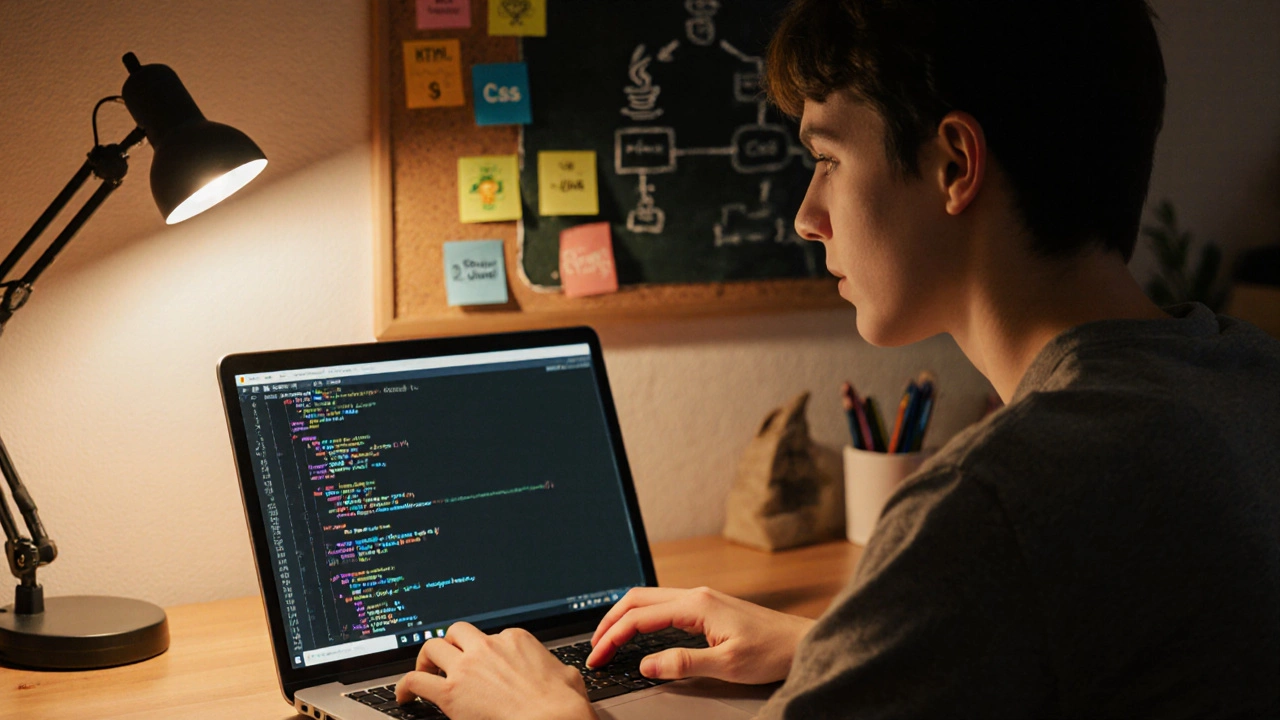Beginner Programming Language Selector
Find Your Perfect Programming Language
Answer a few questions to get a personalized recommendation
What's your primary goal?
What kind of learner are you?
How much time can you commit weekly?
Do you have any prior programming experience?
Why This Tool Works
Based on your responses, this tool will analyze:
- What you want to build
- Your preferred learning style
- How much time you can commit
- Existing experience level
The recommendation considers:
- Ease of learning 10%
- Project feedback speed 25%
- Job market demand 35%
- Community support 30%
Ever stared at a page of code and wondered which one to pick? You’re not alone. Thousands of people start their coding journey each year, and the biggest roadblock is picking the right language to learn first. The good news? You don’t need a crystal ball-just a clear sense of your goals, learning style, and the ecosystem you want to join.
Quick Takeaways
- Python tops the list for most beginners because of its readable syntax and huge community.
- Scratch is perfect for kids or absolute newcomers who prefer visual blocks over text.
- JavaScript lets you build interactive websites instantly-great if you love seeing results in a browser.
- Java offers strong fundamentals and job market demand, but its syntax is a bit heavier.
- HTML & CSS aren’t full‑blown languages, yet they’re essential for anyone interested in web design.
Below we break down why each of these options shines (or falls short) for beginners, compare them side‑by‑side, and give you a simple checklist to decide which one fits you best.
What a Beginner Really Needs
Before we name the best programming language for beginners, let’s talk about the three things most newbies care about:
- Ease of reading and writing. If the code looks like English, you’ll spend less time debugging syntax errors.
- Immediate feedback. Languages that let you see results quickly keep motivation high.
- Community support. A big, active community means tutorials, forums, and open‑source projects are just a click away.
When you match these needs against a language’s attributes, the choice becomes a lot clearer.

Top Five Languages for Beginners
Below each language is introduced with microdata so search engines can recognize the key entities.
Programming language is a set of instructions that lets a human communicate with a computer. While there are hundreds of options, five stand out for newcomers.
1. Python is a high‑level, interpreted language known for its clean, readable syntax.
Python’s design philosophy-"code should be readable and easy to understand"-makes it ideal for people who have never written a line of code before. It powers everything from web back‑ends (Django, Flask) to data science (Pandas, NumPy) and even AI (TensorFlow, PyTorch). The language’s official documentation reports over 10million downloads per month, and the community contributes roughly 1.5million packages on PyPI.
- Difficulty: Very low
- Typical use cases: Web development, automation, data analysis, AI
- Learning resources: freeCodeCamp, Coursera, official tutorial
2. JavaScript is the scripting language of the web, enabling interactive pages and dynamic user experiences.
If you want to see your code run instantly in a browser, JavaScript is unbeatable. Modern frameworks like React, Vue, and Angular have turned it into a full‑stack powerhouse. According to the Stack Overflow Developer Survey 2024, JavaScript remains the most commonly used language for the 9th year in a row.
- Difficulty: Low to moderate (syntax is a bit quirky)
- Typical use cases: Front‑end UI, server‑side with Node.js, mobile apps with React Native
- Learning resources: MDN Web Docs, YouTube tutorials, Codecademy
3. Scratch is a visual, block‑based programming environment developed by MIT.
Scratch replaces text with colourful blocks that snap together, letting kids (and adults) create games, animations, and stories without worrying about syntax. It’s used in elementary schools worldwide and has a vibrant sharing platform where users remix each other’s projects.
- Difficulty: Very low (no typing required)
- Typical use cases: Interactive stories, simple games, learning logical thinking
- Learning resources: Scratch Wiki, offline editor, community tutorials
4. Java is a class‑based, object‑oriented language known for portability across platforms.
Java’s “write once, run anywhere” mantra makes it a staple in enterprise environments, Android app development, and large‑scale systems. Its syntax is more verbose than Python’s, which can be a double‑edged sword: it forces you to understand concepts like types and objects early, building a solid foundation.
- Difficulty: Moderate (strict typing, verbose syntax)
- Typical use cases: Android apps, backend services, large‑scale enterprise software
- Learning resources: Oracle tutorials, Udacity Nanodegree, JetBrains Academy
5. HTML and CSS are markup and styling languages that define the structure and look of webpages.
Strictly speaking, HTML and CSS aren’t programming languages because they don’t contain logic or control flow. Still, they’re the first step for anyone dreaming of building a website. HTML5 introduced semantic tags (like <article> and <section>) that improve accessibility, while CSS Grid and Flexbox let you design responsive layouts without heavy JavaScript.
- Difficulty: Very low (declarative syntax)
- Typical use cases: Web page structure, styling, email templates
- Learning resources: MDN Web Docs, freeCodeCamp, CSS‑Tricks
Comparison Table
| Language | Ease of Learning | Typical First Project | Community Size | Job Market Demand (2025) |
|---|---|---|---|---|
| Python | Very Low | Simple calculator or web scraper | 10M+ developers | High - Data Science, AI, Web |
| JavaScript | Low | Interactive To‑Do list | 12M+ developers | Very High - Frontend, Node.js |
| Scratch | Very Low | Animated story or simple game | 5M+ young creators | Low - Educational settings |
| Java | Moderate | Basic Android app | 9M+ developers | High - Enterprise, Android |
| HTML & CSS | Very Low | Personal portfolio page | 12M+ web creators | Very High - Web design |
How to Pick the Right One for You
Use this short checklist to match your personal goals with a language’s strengths:
- Goal = Build a website fast? Go with JavaScript (for interactivity) or start with HTML/CSS.
- Goal = Automate daily tasks? Python’s simple syntax and extensive standard library make it a perfect fit.
- Goal = Learn concepts without typing? Scratch teaches logic through drag‑and‑drop blocks.
- Goal = Aim for a mobile developer job? Java (Android) or JavaScript (React Native) are the way to go.
- Goal = Want a language that lasts a decade? All five survive, but Python and JavaScript show the strongest growth curves in the last five years.
Don’t feel pressured to pick only one. Many developers start with Python and later add JavaScript for front‑end work, or learn HTML/CSS before diving into a scripting language.
Common Pitfalls and How to Avoid Them
- Skipping the basics. Jumping straight into frameworks (like React) before mastering core JavaScript leads to confusion.
- Choosing based on hype alone. A language that’s trendy today may not align with your long‑term objectives.
- Ignoring community resources. Not using forums like Stack Overflow or Discord channels means you’ll miss out on quick help.
- Sticking to a single tutorial. Mix videos, interactive platforms, and small projects to keep learning fresh.
Next Steps: Your First 30‑Day Learning Plan
Pick a language, then follow this roadmap. Adjust the timeline based on your schedule.
- Week 1 - Fundamentals. Complete an introductory course (e.g., Python’s "Python for Everybody" on Coursera). Write a "Hello, World" program every day.
- Week 2 - Small Project. Build a calculator, a to‑do list, or a simple game in Scratch. Focus on applying loops and conditionals.
- Week 3 - Tools. Install a Visual Studio Code, learn to run code in the terminal, and explore version control with GitHub.
- Week 4 - Community. Join a Discord server or Reddit community, post your project, and ask for feedback. Start contributing a tiny fix to an open‑source repo.
By the end of the month you’ll have a working piece of code, a GitHub repo, and the confidence to keep learning.
Frequently Asked Questions
Is Python really the easiest language for absolute beginners?
Yes. Python’s syntax reads almost like plain English, it has minimal punctuation, and the interpreter gives instant error messages. That lowers the barrier to entry compared with languages that require semicolons, curly braces, or strict type declarations.
Can I learn coding without a computer?
For visual tools like Scratch, a tablet or even a smartphone works fine. However, to progress into Python, JavaScript, or Java you’ll eventually need a desktop/laptop to install an IDE and run scripts.
Do HTML and CSS count as programming languages?
Strictly speaking, they’re markup and styling languages, not programming languages. They don’t contain loops or conditionals, but they are essential building blocks for any web developer.
How long does it take to become job‑ready?
It varies, but a focused 6‑month bootcamp or a diligent self‑study plan (10hours/week) can get you to an entry‑level role, especially with Python or JavaScript, which have strong demand for junior positions.
Should I learn multiple languages at once?
It’s better to master one language’s fundamentals before hopping to another. Once you’re comfortable with concepts like variables, loops, and functions, transferring that knowledge to a second language becomes much easier.
Choosing the right language is the first step-sticking with it, building projects, and joining a community are what really turn a beginner into a coder.
